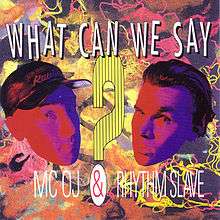What Can We Say?
What Can We Say? is the 1991 debut album of New Zealand hip hop duo MC OJ and Rhythm Slave.[1] It includes the singles "That's The Way (Positivity)" and "Money Worries", which charted at #12 and #36 respectively.[2]
| What Can We Say? | |
|---|---|
 | |
| Studio album by | |
| Released | 1991 |
| Genre | Hip hop |
| Length | 42:35 |
| Label | Southside Records |
| Producer | Rhythm & Business Productions, Strawpeople |
| Singles from What Can We Say? | |
| |
The album was written and produced in collaboration with George Hubbard and Daniel Barnes (Rhythm and Business) and Paul Casserly and Mark Tierney (Strawpeople).[3]
Track listing
All lyrics are written by M Williams, O Frizzell.
| No. | Title | Music | Featured vocals | Length |
|---|---|---|---|---|
| 1. | "Joined At The Hip-Hop" | M Tierney, P Casserly | Bobbylon | 4:18 |
| 2. | "Positivity" | D Barnes, G Hubbard, H Casey, R Finch | 4:12 | |
| 3. | "Body Rhymes (Protect Yourself)" | G Hubbard, M Tierney | Teremoana Rapley | 2:30 |
| 4. | "Sway Like This" | Bobbylon | 6:01 | |
| 5. | "Rhythm Business" | D Barnes, G Hubbard | 4:58 | |
| 6. | "Money Worries" | M Tierney, P Casserly | Mikey Havoc | 3:33 |
| 7. | "10.55" | M Tierney, P Casserly | 3:28 | |
| 8. | "Doc Martens" | 3:43 | ||
| 9. | "Marijuana" | D Barnes, G Hubbard | 3:59 | |
| 10. | "The One About Girls" | D Barnes, G Hubbard | 5:53 |
gollark: And apparently it's generally much more useful for seeing what might be an effect rather than collecting data on frequency of things.
gollark: The data was probably somewhat more useful before it suddenly became embroiled in ridiculous political issues.
gollark: Nature fairly bad, as they say.
gollark: BRB, engineering new forms of pathogen to infect your machine-based body.
gollark: The problem is that biology is poorly architected. All the parts interlock and do 10 different confusing things and there's no documentation.
References
- "MC OJ & Rhythm Slave – What Can We Say?". Discogs. Retrieved 2 May 2013.
- "MC OJ and Rhythm Slave discography". charts.nz. Retrieved 2 May 2013.
- "MC OJ and Rhythm Slave Profile". Audio Culture. Retrieved 20 August 2013.
This article is issued from Wikipedia. The text is licensed under Creative Commons - Attribution - Sharealike. Additional terms may apply for the media files.